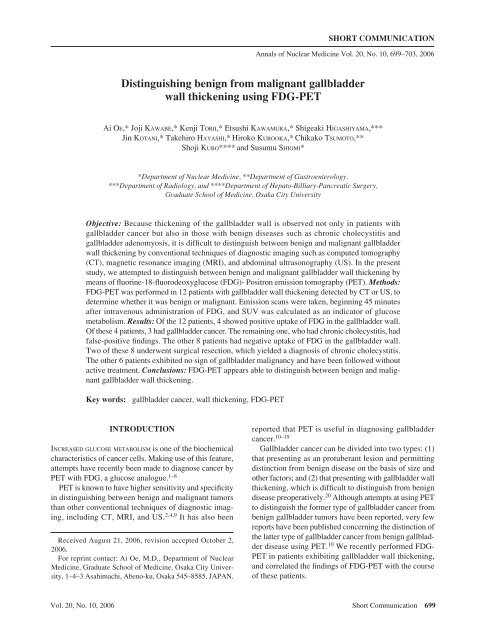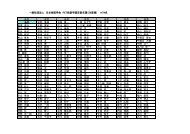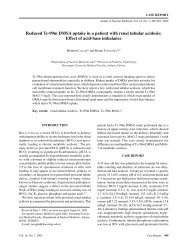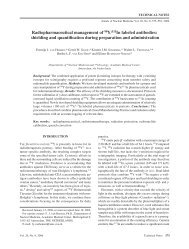Distinguishing benign from malignant gallbladder wall thickening ...
Distinguishing benign from malignant gallbladder wall thickening ...
Distinguishing benign from malignant gallbladder wall thickening ...
You also want an ePaper? Increase the reach of your titles
YUMPU automatically turns print PDFs into web optimized ePapers that Google loves.
Vol. 20, No. 10, 2006<br />
Annals of Nuclear Medicine Vol. 20, No. 10, 699–703, 2006<br />
<strong>Distinguishing</strong> <strong>benign</strong> <strong>from</strong> <strong>malignant</strong> <strong>gallbladder</strong><br />
<strong>wall</strong> <strong>thickening</strong> using FDG-PET<br />
INTRODUCTION<br />
INCREASED GLUCOSE METABOLISM is one of the biochemical<br />
characteristics of cancer cells. Making use of this feature,<br />
attempts have recently been made to diagnose cancer by<br />
PET with FDG, a glucose analogue. 1–8<br />
PET is known to have higher sensitivity and specificity<br />
in distinguishing between <strong>benign</strong> and <strong>malignant</strong> tumors<br />
than other conventional techniques of diagnostic imaging,<br />
including CT, MRI, and US. 2,4,9 It has also been<br />
Received August 21, 2006, revision accepted October 2,<br />
2006.<br />
For reprint contact: Ai Oe, M.D., Department of Nuclear<br />
Medicine, Graduate School of Medicine, Osaka City University,<br />
1–4–3 Asahimachi, Abeno-ku, Osaka 545–8585, JAPAN.<br />
SHORT COMMUNICATION<br />
Ai OE,* Joji KAWABE,* Kenji TORII,* Etsushi KAWAMURA,* Shigeaki HIGASHIYAMA,***<br />
Jin KOTANI,* Takehiro HAYASHI,* Hiroko KUROOKA,* Chikako TSUMOTO,**<br />
Shoji KUBO**** and Susumu SHIOMI*<br />
*Department of Nuclear Medicine, **Department of Gastroenterology,<br />
***Department of Radiology, and ****Department of Hepato-Billiary-Pancreatic Surgery,<br />
Graduate School of Medicine, Osaka City University<br />
Objective: Because <strong>thickening</strong> of the <strong>gallbladder</strong> <strong>wall</strong> is observed not only in patients with<br />
<strong>gallbladder</strong> cancer but also in those with <strong>benign</strong> diseases such as chronic cholecystitis and<br />
<strong>gallbladder</strong> adenomyosis, it is difficult to distinguish between <strong>benign</strong> and <strong>malignant</strong> <strong>gallbladder</strong><br />
<strong>wall</strong> <strong>thickening</strong> by conventional techniques of diagnostic imaging such as computed tomography<br />
(CT), magnetic resonance imaging (MRI), and abdominal ultrasonography (US). In the present<br />
study, we attempted to distinguish between <strong>benign</strong> and <strong>malignant</strong> <strong>gallbladder</strong> <strong>wall</strong> <strong>thickening</strong> by<br />
means of fluorine-18-fluorodeoxyglucose (FDG)- Positron emission tomography (PET). Methods:<br />
FDG-PET was performed in 12 patients with <strong>gallbladder</strong> <strong>wall</strong> <strong>thickening</strong> detected by CT or US, to<br />
determine whether it was <strong>benign</strong> or <strong>malignant</strong>. Emission scans were taken, beginning 45 minutes<br />
after intravenous administration of FDG, and SUV was calculated as an indicator of glucose<br />
metabolism. Results: Of the 12 patients, 4 showed positive uptake of FDG in the <strong>gallbladder</strong> <strong>wall</strong>.<br />
Of these 4 patients, 3 had <strong>gallbladder</strong> cancer. The remaining one, who had chronic cholecystitis, had<br />
false-positive findings. The other 8 patients had negative uptake of FDG in the <strong>gallbladder</strong> <strong>wall</strong>.<br />
Two of these 8 underwent surgical resection, which yielded a diagnosis of chronic cholecystitis.<br />
The other 6 patients exhibited no sign of <strong>gallbladder</strong> malignancy and have been followed without<br />
active treatment. Conclusions: FDG-PET appears able to distinguish between <strong>benign</strong> and <strong>malignant</strong><br />
<strong>gallbladder</strong> <strong>wall</strong> <strong>thickening</strong>.<br />
Key words: <strong>gallbladder</strong> cancer, <strong>wall</strong> <strong>thickening</strong>, FDG-PET<br />
reported that PET is useful in diagnosing <strong>gallbladder</strong><br />
cancer. 10–19<br />
Gallbladder cancer can be divided into two types: (1)<br />
that presenting as an protuberant lesion and permitting<br />
distinction <strong>from</strong> <strong>benign</strong> disease on the basis of size and<br />
other factors; and (2) that presenting with <strong>gallbladder</strong> <strong>wall</strong><br />
<strong>thickening</strong>, which is difficult to distinguish <strong>from</strong> <strong>benign</strong><br />
disease preoperatively. 20 Although attempts at using PET<br />
to distinguish the former type of <strong>gallbladder</strong> cancer <strong>from</strong><br />
<strong>benign</strong> <strong>gallbladder</strong> tumors have been reported, very few<br />
reports have been published concerning the distinction of<br />
the latter type of <strong>gallbladder</strong> cancer <strong>from</strong> <strong>benign</strong> <strong>gallbladder</strong><br />
disease using PET. 10 We recently performed FDG-<br />
PET in patients exhibiting <strong>gallbladder</strong> <strong>wall</strong> <strong>thickening</strong>,<br />
and correlated the findings of FDG-PET with the course<br />
of these patients.<br />
Short Communication 699
Table 1 Patient characteristics<br />
Patient no. Age (yrs) Sex Diagnosis FDG SUV<br />
1 74 M GBC + 5.1<br />
2 84 F GBC + 9.1<br />
3 57 F GBC + 5.5<br />
4 60 F Chronic cholecystitis + 4.7<br />
5 69 M Chronic cholecystitis − ND<br />
6 64 M Chronic cholecystitis − ND<br />
7 60 M ND − ND<br />
8 83 F ND − ND<br />
9 67 M ND − ND<br />
10 65 M ND − ND<br />
11 64 M ND − ND<br />
12 64 M ND − ND<br />
Sex; M = Male, F = Female GBC = Gallbladder cancer ND = Not Done SUV = standardized uptake value<br />
MATERIALS AND METHODS<br />
Patients<br />
This was a retrospective study involving 12 patients with<br />
<strong>gallbladder</strong> <strong>wall</strong> <strong>thickening</strong> who underwent FDG-PET<br />
between November 2001 and August 2006 (Table 1). In<br />
all of these patients, <strong>gallbladder</strong> <strong>wall</strong> <strong>thickening</strong> was<br />
revealed by abdominal ultrasonography (US) or CT scans<br />
prior to PET. There were 8 males and 4 females, with ages<br />
ranging <strong>from</strong> 57 to 83 years (mean: 67.6 years).<br />
PET imaging protocol<br />
FDG was produced with the NKK-Oxford superconducting<br />
cyclotron and NKK synthesis system. A HEADTOME<br />
IV SET-1400W-10 (Shimadzu Corp., Japan), which has<br />
4 detector rings providing 7 contiguous slices at 13 mm<br />
intervals, was employed for the PET studies. The effective<br />
spatial resolution was 14 mm at full width at half<br />
maximum (FWHM). Before emission scanning, transmission<br />
scans were performed with a 68 Ge/ 68 Ga ring<br />
source for attenuation correction. Images were obtained<br />
<strong>from</strong> 40 to 55 minutes after intravenous injection of 185–<br />
370 MBq FDG while fasting. 9<br />
Data analysis<br />
Patients exhibiting higher FDG uptake by the <strong>gallbladder</strong><br />
in regions with <strong>wall</strong> <strong>thickening</strong> than in normal liver were<br />
considered positive. For quantitative evaluation of FDG<br />
accumulation in tumor, we designated regions of interest<br />
(ROIs: circles 8 mm in diameter) in the regions of <strong>gallbladder</strong><br />
<strong>wall</strong> exhibiting <strong>thickening</strong> compared to other<br />
images. The mean of the standardized uptake values<br />
(SUV = tissue concentration/activity injected per body<br />
weight) of the ROIs were determined. Disease was rated<br />
<strong>benign</strong> or <strong>malignant</strong> on the basis of the findings of histopathologic<br />
examination of surgical specimens and the<br />
clinical course of individual patients.<br />
700 Ai Oe, Joji Kawabe, Kenji Torii, et al<br />
RESULTS<br />
Of the 12 patients, 4 were rated as FDG-positive (SUV<br />
4.7–9.4). Of these 4, 3 had <strong>gallbladder</strong> cancer (Fig. 1) and<br />
1 had chronic cholecystitis (Fig. 2). Eight patients were<br />
FDG-negative. Of these 8, 2 underwent surgery and were<br />
diagnosed with chronic cholecystitis (Fig. 3). The other 6<br />
were diagnosed with chronic cholecystitis on the basis of<br />
a combination of FDG-PET findings and other test results,<br />
and have been followed without active treatment (Table<br />
1).<br />
When used for the diagnosis of <strong>gallbladder</strong> cancer,<br />
FDG had a sensitivity of 75%, a specificity of 100%, and<br />
an accuracy of 93%.<br />
DISCUSSION<br />
Gallbladder cancer is a relatively rare disease. At present,<br />
surgical resection is the only means available to treat it. 21<br />
However, since this disease lacks specific symptoms and<br />
is often detected in advanced stages, the five-year survival<br />
rate for patients with inoperable <strong>gallbladder</strong> cancer is<br />
below 10%, and the mean duration of survival of these<br />
patients is 6 months. 13 Although early diagnosis and<br />
treatment are desirable when dealing with this cancer,<br />
there are few characteristic clinical symptoms, and it is<br />
difficult at present to detect this cancer in the early stage<br />
with diagnostic imaging. 13<br />
FDG-PET has recently been used frequently for the<br />
detection and evaluation of tumors. PET itself has been<br />
used to distinguish between <strong>benign</strong> and <strong>malignant</strong> tumors,<br />
for staging of tumors, and to follow patients with<br />
tumors. In the past, US, CT, MRI, ERCP, and other<br />
imaging modalities were used for the diagnosis of <strong>gallbladder</strong><br />
cancer. It has recently begun to be reported that<br />
PET is also useful in the diagnosis of <strong>gallbladder</strong> cancer. 18<br />
Rodriguez-Frenandez et al. reported that PET had a<br />
sensitivity of 75% and a specificity of 82% in a study of<br />
16 cases of <strong>gallbladder</strong> disease (with <strong>gallbladder</strong> <strong>wall</strong><br />
Annals of Nuclear Medicine
Vol. 20, No. 10, 2006<br />
a b<br />
Fig. 1 Case 2. (a) Abdominal CT scan shows whole <strong>wall</strong> <strong>thickening</strong> of the <strong>gallbladder</strong> and gallstone.<br />
(b) FDG-PET shows increased uptake (SUV 9.1) around the whole <strong>wall</strong> and at the neck of the<br />
<strong>gallbladder</strong>. Also a part of the duodenum (arrow) showed increased uptake. This case was diagnosed<br />
as advanced <strong>gallbladder</strong> carcinoma with duodenal invasion.<br />
a b<br />
Fig. 2 Case 4. (a) Abdominal CT scan shows whole <strong>wall</strong> <strong>thickening</strong> of the <strong>gallbladder</strong> and gallstones.<br />
(b) FDG-PET shows increased uptake (SUV 4.7) at the bed of the <strong>gallbladder</strong>. This case was diagnosed<br />
as cholecystitis with an excision specimen. The <strong>gallbladder</strong> <strong>wall</strong> adhered to the liver due to severe<br />
inflammation.<br />
a b<br />
Fig. 3 Case 5. (a) Abdominal CT scan shows whole <strong>wall</strong> <strong>thickening</strong> of the <strong>gallbladder</strong>. (b) FDG-PET<br />
does not show increased uptake at the <strong>gallbladder</strong>. This case was diagnosed as chronic cholecystitis.<br />
Short Communication 701
<strong>thickening</strong> observed in 7 cases). 10 Anderson et al. evaluated<br />
the usefulness of PET in cases of <strong>gallbladder</strong> carcinoma<br />
and cholangiocarcinoma, as well as in 14 cases of<br />
<strong>gallbladder</strong> disease, and reported that the sensitivity of<br />
PET in detecting <strong>gallbladder</strong> cancer was 78%. 11 Koh et al.<br />
performed PET on 16 patients with protuberant lesions of<br />
the <strong>gallbladder</strong>, and reported that PET was superior to CT<br />
in diagnosing <strong>gallbladder</strong> cancer, with a sensitivity of<br />
75% and specificity of 87.5%. 12<br />
Gallbladder cancer can be divided into two types, that<br />
presenting as an protuberant lesion and that characterized<br />
by <strong>gallbladder</strong> <strong>wall</strong> <strong>thickening</strong>. It has been thought that a<br />
protuberant lesion in the <strong>gallbladder</strong> over 15 mm in size<br />
is very likely to be <strong>malignant</strong>. 22 The protuberant type can<br />
be distinguished between <strong>benign</strong> and <strong>malignant</strong> tumors<br />
with the conventional imaging techniques, CT, MRI, US,<br />
and so on. The latter type of <strong>gallbladder</strong> cancer is more<br />
difficult to distinguish preoperatively <strong>from</strong> <strong>benign</strong> <strong>gallbladder</strong><br />
disease, since <strong>wall</strong> <strong>thickening</strong> is also noted in<br />
cases of cholecystitis, adenomyomatosis, and other conditions.<br />
In the present study, we performed PET on patients<br />
found only by CT or US to have <strong>gallbladder</strong> <strong>wall</strong> <strong>thickening</strong>.<br />
When used to distinguish between <strong>malignant</strong> and<br />
<strong>benign</strong> <strong>gallbladder</strong> <strong>wall</strong> <strong>thickening</strong>, PET had a sensitivity<br />
of 75% and specificity of 100%. There was one case (Case<br />
4) in which the results of PET examination were falsepositive.<br />
Acute/chronic cholecystitis and xanthogranulomatous<br />
cholecystitis are reported to be sometimes falsepositive<br />
in the <strong>gallbladder</strong> <strong>wall</strong> <strong>thickening</strong> type, 12,14,16,17<br />
because FDG is taken up by activated inflammatory cells.<br />
Nishiyama et al. stated that false-positive findings are<br />
likely in cases in which CRP > 1, that CRP is a good<br />
predictor of the specificity of PET, and that not only CRP<br />
but also other clinical or laboratory data emphasizing the<br />
exsistence of acute inflammatory conditions might be<br />
helpful. 16 In our study the false-positive case had developed<br />
acute cholecystitis one year previously. At the time<br />
of PET, this patient had neither clinical symptoms nor<br />
hematological findings of acute inflammation, with a<br />
CRP of 0.2. But the postoperative pathologic examination<br />
revealed intense inflammation and adhesion of the <strong>gallbladder</strong><br />
<strong>wall</strong> to the liver, where there was abnormal FDG<br />
accumulation. FDG was thought to be taken up because<br />
there were severe inflammatory lesions at the cell level<br />
even though CRP was negative.<br />
The results of the present study indicate that preoperative<br />
distinction between <strong>benign</strong> and <strong>malignant</strong> <strong>gallbladder</strong><br />
<strong>wall</strong> <strong>thickening</strong> is possible with PET. If PET is used<br />
for this purpose, it may be possible to avoid unnecessary<br />
surgery. Because the number of cases evaluated in this<br />
study was very small, and because very few reports have<br />
been published on this topic, further evaluation is needed<br />
in a larger number of cases.<br />
702 Ai Oe, Joji Kawabe, Kenji Torii, et al<br />
REFERENCES<br />
1. Van den Abbeele AD, Badawi RD. Use of positron emission<br />
tomography in oncology and its potential role to assess<br />
response to imatinib mesylate therapy in gastrointestinal<br />
stromal tumors (GISTs). Eur J Cancer 2002; 38 (Suppl 5):<br />
S60–65.<br />
2. Kitagawa Y, Nishizawa S, Sano K, Ogasawara T, Nakamura<br />
M, Sadato N, et al. Prospective comparison of 18 F-FDG<br />
PET with conventional imaging modalities (MRI, CT, and<br />
67 Ga scintigraphy) in assessment of combined intraarterial<br />
chemotherapy and radiotherapy for head and neck carcinoma.<br />
J Nucl Med 2003; 44: 198–206.<br />
3. Hoh CK, Hawkins RA, Glaspy JA, Dahlbom M, Tse NY,<br />
Hoffman EJ, et al. Cancer detection with whole-body PET<br />
using 2-[ 18 F]fluoro-2-deoxy-D-glucose. J Comput Assist<br />
Tomogr 1993; 17: 582–589.<br />
4. Kubota K, Yokoyama J, Yamaguchi K, Ono S, Qureshy A,<br />
Itoh M, et al. FDG-PET delayed imaging for the detection<br />
of head and neck cancer recurrence after radio-chemotherapy:<br />
comparison with MRI/CT. Eur J Nucl Med Mol<br />
Imaging 2004; 31: 590–595.<br />
5. Kubota K. From rumor biology to clinical PET: A review of<br />
positron emission tomography (PET) in oncology. Ann<br />
Nucl Med 2001; 15: 471–486.<br />
6. Kelloff GJ, Hoffman JM, Johnson B, Scher HI, Siegel BA,<br />
Cheng EY, et al. Progress and promise of FDG-PET imaging<br />
for cancer patient management and oncologic drug<br />
development. Clin Cancer Res 2005; 11: 2785–2808.<br />
7. Strauss LG, Conti PS. The applications of PET in clinical<br />
oncology. J Nucl Med 1991; 32: 623–648.<br />
8. Strauss LG. Positron Emission Tomography: Current Role<br />
for Diagnosis and Therapy Monitoring in Oncology. Oncologist<br />
1997; 2: 381–388.<br />
9. Kunishima S, Taniguchi H, Yamaguchi A, Koh T, Yamagishi<br />
H. Evaluation of Abdominal Tumors with [F-18]fluorodeoxyglucose<br />
positron emission tomography. Clin Positron<br />
Imaging 2000; 3: 91–96.<br />
10. Rodriguez-Fernandez A, Gomez-Rio M, Llamas-Elvira<br />
JM, Ortega-Lozano S, Ferron-Orihuela JA, Ramia-Angel<br />
JM, et al. Positron-emission tomography with fluorine-18fluoro-2-deoxy-D-glucose<br />
for <strong>gallbladder</strong> cancer diagnosis.<br />
Am J Surg 2004; 188: 171–175.<br />
11. Anderson CD, Rice MH, Pinson CW, Chapman WC, Chari<br />
RS, Delbeke D. Fluorodeoxyglucose PET imaging in the<br />
evaluation of <strong>gallbladder</strong> carcinoma and cholangiocarcinoma.<br />
J Gastrointest Surg 2004; 8: 90–97.<br />
12. Koh T, Taniguchi H, Yamaguchi A, Kunishima S, Yamagishi<br />
H. Differential diagnosis of <strong>gallbladder</strong> cancer using positron<br />
emission tomography with fluorine-18-labeled fluorodeoxyglucose<br />
(FDG-PET). J Surg Oncol 2003; 84: 74–81.<br />
13. Shukla HS. Gallbladder cancer. J Surg Oncol 2006; 93:<br />
604–606.<br />
14. Rodriguez-Fernandez A, Gomez-Rio M, Medina-Benitez<br />
A, Moral JV, Ramos-Font C, Ramia-Angel JM. Application<br />
of modern imaging methods in diagnosis of <strong>gallbladder</strong><br />
cancer. J Surg Oncol 2006; 93: 650–664.<br />
15. Petrowsky H, Wildbrett P, Husarik DB, Hany TF, Tam S,<br />
Jochum W, et al. Impact of integrated positron emission<br />
tomography and computed tomography on staging and<br />
management of <strong>gallbladder</strong> cancer and cholangiocarcinoma.<br />
Annals of Nuclear Medicine
J Hepatol 2006; 45: 43–50.<br />
16. Nishiyama Y, Yamamoto Y, Fukunaga K, Kimura N, Miki<br />
A, Sasakawa Y, et al. Dual-time-point 18 F-FDG PET for the<br />
evaluation of <strong>gallbladder</strong> carcinoma. J Nucl Med 2006; 47:<br />
633–638.<br />
17. Rosenbaum SJ, Stergar H, Antoch G, Veit P, Bockisch A,<br />
Kuhl H. Staging and follow-up of gastrointestinal tumors<br />
with PET/CT. Abdom Imaging 2006; 31: 25–35.<br />
18. Chander S, Lee P, Zingas AP, Joyrich RN, Zak IT, Bloom<br />
DA. PET imaging of <strong>gallbladder</strong> carcinoma. Clin Nucl Med<br />
2005; 30: 804–805.<br />
19. Wakabayashi H, Akamoto S, Yachida S, Okano K, Izuishi<br />
K, Nishiyama Y. Significance of fluorodeoxyglucose PET<br />
imaging in the diagnosis of malignancies in patients with<br />
Vol. 20, No. 10, 2006<br />
biliary stricture. Eur J Surg Oncol 2005; 31: 1175–1179.<br />
20. Yoshimitsu K, Honda H, Jimi M, Kuroiwa T, Hanada K, Irie<br />
H. MR diagnosis of adenomyomatosis of the <strong>gallbladder</strong><br />
and differentiation <strong>from</strong> <strong>gallbladder</strong> carcinoma: importance<br />
of showing Rokitansky-Aschoff sinuses. AJR 1999;<br />
172: 1541–1546.<br />
21. Hirooka Y, Naitoh Y, Goto H, Furukawa T, Ito A, Hayakawa<br />
T. Differential diagnosis of gall-bladder masses using colour<br />
Doppler ultrasonography. J Gastroenterol Hepatol 1996;<br />
11: 840–846.<br />
22. Yang HL, Sun YG, Wang Z. Polypoid lesions of the<br />
<strong>gallbladder</strong>: Diagnosis and indications for surgery. Br J<br />
Surg 1992; 229: 498–504.<br />
Short Communication 703







